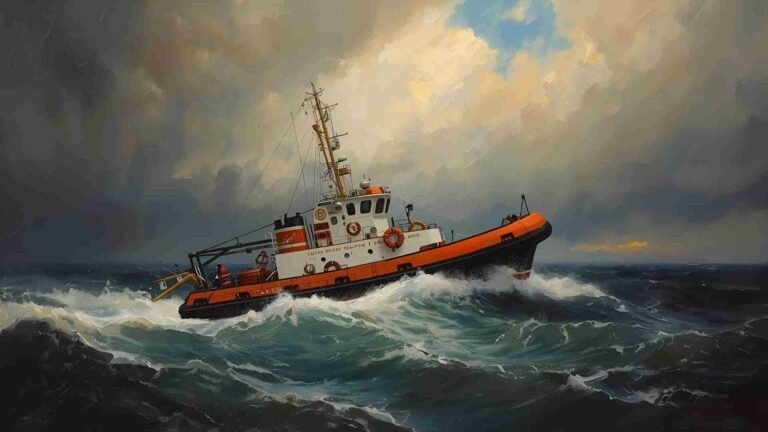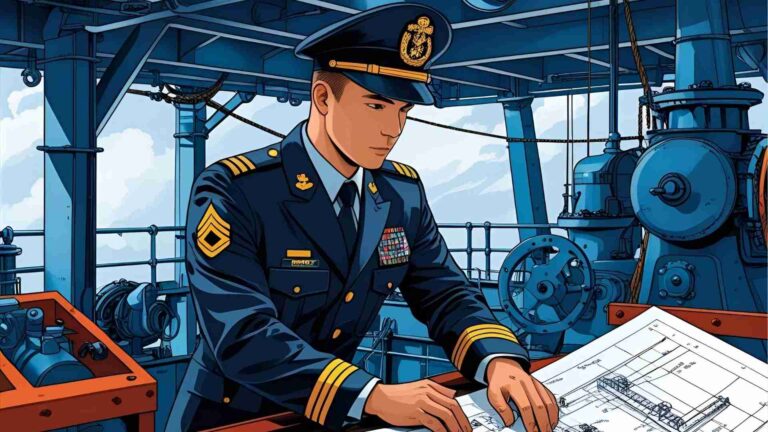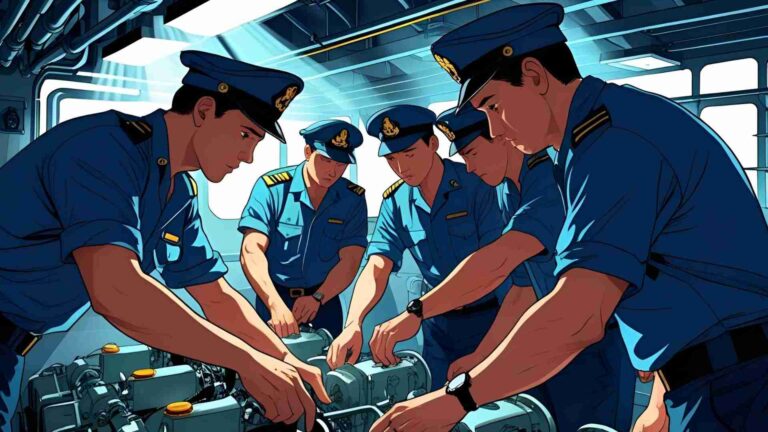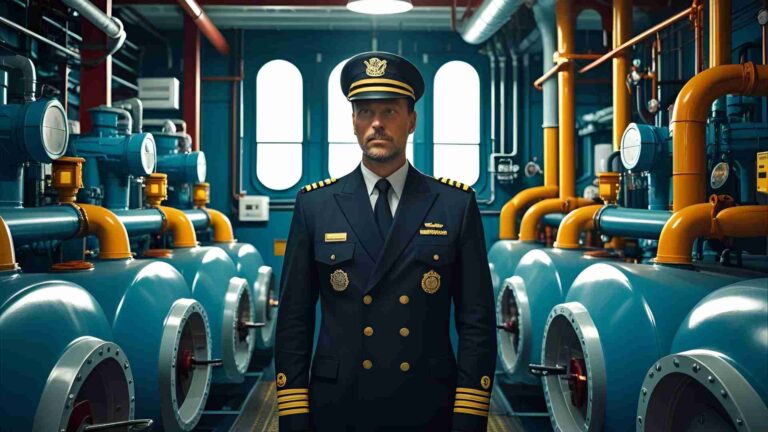Top 35 Questions and Answers for Oral Exams of Marine Third Engineers in UK
The UK Marine Third Engineer oral exam, conducted by the Maritime and Coastguard Agency (MCA), tests candidates on technical knowledge, practical skills, and emergency response capabilities. This comprehensive guide presents 35 critical questions in a question-and-answer format, covering marine diesel engines, auxiliary systems, safety protocols, and regulatory compliance.
1. How do you start a marine diesel engine?
Answer: Starting a marine diesel engine involves a systematic procedure to ensure safety and efficiency. First, conduct pre-start checks: verify fuel, oil, and cooling water levels, ensure the engine is disengaged from the propeller shaft, and confirm the fuel system is primed. Check lubrication system pressure and test alarms and interlocks. Open air and fuel supply valves, set the engine to the starting position, and engage the starting mechanism (air or electric). Once the engine starts, monitor oil pressure, temperature, and exhaust for abnormalities.
Pre-Start Checks
| Check | Purpose |
|---|---|
| Fuel Level | Ensures sufficient fuel supply |
| Oil Level and Pressure | Prevents engine damage due to low lube |
| Cooling Water | Avoids overheating |
| Air Supply | Ensures combustion air availability |
2. What are the key components and functions of a ship’s steering gear system?
Answer: The steering gear system controls the vessel’s direction by moving the rudder. Key components include the hydraulic pump, telemotor, rudder actuator, and control unit. The pump generates hydraulic pressure to move the rudder, the telemotor transmits bridge commands, and the actuator adjusts the rudder angle. Safety features like overload protection and emergency manual steering ensure reliability.
Steering Gear System

Maintenance involves checking hydraulic fluid levels, inspecting for leaks, and testing emergency steering.
3. How do you purify heavy fuel oil using a purifier?
Answer: Heavy fuel oil (HFO) purification removes water, sludge, and solids to protect the engine. Using a centrifugal purifier, heat HFO to 95–98°C to reduce viscosity. Start the purifier, stabilize bowl speed, and feed HFO into the unit. Adjust the gravity disc for optimal separation, and monitor discharge for water and sludge removal. Regular maintenance includes cleaning the bowl, checking seals, and ensuring motor functionality.
4. How do you maintain and troubleshoot a centrifugal pump?
Answer: Centrifugal pumps transfer fluids like fuel or water. Maintenance includes checking impeller alignment, lubricating bearings, and inspecting seals. Troubleshooting addresses issues like cavitation (low suction pressure) or reduced flow (blocked impeller). Regular checks prevent failures and ensure efficient operation.
Troubleshooting
| Issue | Cause | Solution |
|---|---|---|
| Cavitation | Low suction pressure | Increase suction head |
| Reduced Flow | Blocked impeller | Clean impeller and suction line |
| Vibration | Misaligned shaft | Realign pump and motor |
5. What is the purpose and operation of a turbocharger in a marine diesel engine?
Answer: A turbocharger boosts engine power by forcing extra air into the combustion chamber. It consists of a turbine and compressor connected by a shaft. Exhaust gases spin the turbine, driving the compressor to draw and compress air. Maintenance includes cleaning air filters, inspecting turbine blades, and lubricating bearings.
6. How do you carry out maintenance on a ship’s generator?
Answer: Generators supply electrical power for shipboard systems. Maintenance involves checking fuel and oil levels, inspecting cooling systems, and testing alternator output. Clean air filters, tighten electrical connections, and monitor voltage and frequency. Troubleshoot issues like unstable voltage by checking the governor or Automatic Voltage Regulator (AVR).
7. Why are bilge and ballast systems important onboard a vessel?
Answer: The bilge system removes water from lower compartments to prevent flooding and maintain stability, using pumps, strainers, and non-return valves. The ballast system adjusts stability by pumping water into or out of tanks. Maintenance includes cleaning strainers, testing pumps, and checking valves.
Ballast System Flow

8. How do you perform bunkering, and what safety precautions are required?
Answer: Bunkering transfers fuel from a supplier to the ship’s tanks. Conduct pre-bunkering checks, verify tank capacities, and ensure communication with the supplier. Safety precautions include wearing PPE, using spill containment, and monitoring for leaks. Post-bunkering, test fuel samples and log quantities.
Safety Checklist:
- Deploy spill kits.
- Use flameproof communication devices.
- Post “No Smoking” signs.
- Monitor tank levels to prevent overflow.
9. What is the function and operation of an oily water separator?
Answer: The oily water separator (OWS) removes oil from bilge water to meet MARPOL’s 15 ppm oil discharge limit. It uses gravity and coalescing plates to separate oil. Maintenance includes cleaning plates, checking sensors, and ensuring the oil content monitor functions.
10. What is the purpose of main engine interlocks and alarms, and how do they work?
Answer: Interlocks prevent engine operation under unsafe conditions, such as low oil pressure, while alarms alert engineers to parameter deviations like high exhaust temperature. Sensors detect issues, triggering alarms or shutdowns. Regular testing ensures functionality.
11. How does a ship’s refrigeration system operate, and what maintenance is required?
Answer: The refrigeration system maintains low temperatures using the vapor-compression cycle. Components include a compressor, condenser, evaporator, and expansion valve. Maintenance involves checking refrigerant levels, inspecting compressor belts, and cleaning condenser coils.
Refrigeration Cycle

12. How do you adjust fuel injection timing on a marine diesel engine?
Answer: Adjust fuel injection timing by aligning the fuel pump camshaft with the crankshaft using timing marks or a dial gauge. Correct timing ensures efficient combustion. Consult the engine manual for specific settings to avoid knocking or power loss.
13. What is the role of a marine engineer in a shipboard emergency?
Answer: In emergencies like fires or hull breaches, the Third Engineer assists in firefighting, damage control, and machinery operation. For fires, they isolate fuel lines or operate fire pumps. For hull breaches, they help seal compartments and pump out water.
14. What are the key requirements of MARPOL Annex VI for marine engineers?
Answer: MARPOL Annex VI regulates air emissions (SOx, NOx, greenhouse gases). Engineers ensure compliance by using low-sulfur fuels, maintaining scrubbers, and monitoring emissions. Non-compliance risks fines or detention.
15. What is the function of a ship’s main engine lubrication system?
Answer: The lubrication system reduces friction and wear, using oil pumps, filters, and coolers. Maintenance includes checking oil levels, replacing filters, and testing for contamination to extend engine life and prevent overheating.
16. How do you maintain and troubleshoot an air compressor?
Answer: Air compressors supply air for engine starting and tools. Maintenance includes draining receiver water, checking oil levels, and inspecting valves. Troubleshoot low pressure (leaks) or overheating (clogged coolers).
17. What is the function of a ship’s main engine cooling system, and how is it maintained?
Answer: The cooling system prevents engine overheating using seawater or freshwater circuits. Maintenance includes cleaning heat exchangers, checking pump performance, and monitoring coolant temperature. Add corrosion inhibitors to freshwater systems.
18. What is the purpose of a ship’s incinerator, and what regulations govern its operation?
Answer: The incinerator burns waste oil and solids, reducing waste volume. It must comply with MARPOL Annex VI emission standards. Maintenance includes cleaning burners, checking refractory linings, and testing safety shutoffs.
19. Why is proper valve maintenance important, and how is it performed?
Answer: Valves control fluid flow, and poor maintenance causes leaks or system failures. Inspect seats, lubricate stems, and check for leaks. Replace worn parts to ensure reliable operation.
20. What are the key safety procedures for working in the engine room?
Answer: Engine room safety includes wearing PPE, following lockout-tagout procedures, and ensuring ventilation. Mitigate fire hazards by maintaining fire detection systems and securing flammable materials. Conduct regular safety drills.
Safety Precautions
| Hazard | Precaution |
|---|---|
| Fire | Maintain fire extinguishers |
| Noise | Use ear protection |
| Confined Spaces | Ensure proper ventilation |
21. What checks are performed before starting the main engine?
Answer: Check fuel, oil, and cooling water levels, ensure air system pressure, and verify interlocks and alarms. Confirm the engine is disengaged from the propeller and record findings in the logbook.
22. How do you prepare for an engine overhaul?
Answer: An overhaul involves disassembling and replacing worn parts like pistons or bearings. Isolate the engine, drain fluids, and gather tools and spares. Follow manufacturer guidelines for reassembly.
23. What are the indicators of a scavenge fire, and how do you respond?
Answer: Indicators include high exhaust temperatures and smoke. Reduce engine speed, cut fuel supply, and use fixed firefighting systems like CO2 to extinguish the fire.
24. How do you take over a watch in the engine room?
Answer: Review the logbook, check machinery parameters (fuel, oil, cooling), and inspect critical systems. Communicate with the outgoing engineer to understand ongoing issues or tasks.
25. What are star and delta connections, and how do they function?
Answer: Star connections link motor windings to a common point, providing lower voltage, while delta forms a closed loop for higher power. Both include safeties like overload protection.
Star Connection

Delta Connection

26. How do you perform an Insulation Resistance (IR) test on an electric motor?
Answer: Disconnect the motor, apply a test voltage (e.g., 500V) using a megger, and measure insulation resistance. Low readings indicate insulation failure, requiring repair or replacement.
27. What are the requirements for a ship’s fire pumps?
Answer: Fire pumps supply water for firefighting, requiring at least two independent pumps with sufficient pressure. Maintenance includes testing capacity, checking valves, and ensuring power supply reliability.
28. What is an Emergency Escape Breathing Device (EEBD), and what are its regulations?
Answer: EEBDs provide 15 minutes of breathable air during emergencies. Located in engine rooms and accommodation areas, they must comply with SOLAS. Regular checks ensure functionality.
29. What are SOLAS and STCW, and what are their key requirements?
Answer: SOLAS ensures safety through standards for fire protection and life-saving appliances. STCW (Standards of Training, Certification, and Watchkeeping) mandates crew training and certification.
30. What are the duties and responsibilities of a Third Engineer?
Answer: The Third Engineer oversees engine room operations, maintains machinery, and ensures compliance with safety and environmental regulations. They assist in emergencies, conduct watchkeeping, and log performance.
31. How do you perform boiler water testing?
Answer: Test boiler water for pH, alkalinity, and phosphate levels to prevent corrosion and scaling. Adjust chemicals as needed and record results to ensure boiler efficiency.
32. What are the different types of marine fuels, and how do they affect engine performance?
Answer: Marine fuels include HFO (cost-effective, requires purification), MDO (cleaner, expensive), and LNG (low emissions). Fuel quality impacts combustion efficiency and emissions.
33. How does the ship’s electrical power generation and distribution system operate?
Answer: Generators produce power, distributed via switchboards and panels. Maintenance includes testing circuit breakers, checking insulation, and balancing loads to prevent blackouts.
34. What is the function of the ballast water treatment system?
Answer: The system treats ballast water to prevent ecological damage, using filtration, UV, or chemical methods. Maintenance includes cleaning filters and calibrating sensors.
35. How do hydraulic systems operate on a ship?
Answer: Hydraulic systems power cranes, winches, and steering gear. Maintenance includes checking fluid levels, inspecting hoses, and testing pressure relief valves.
Conclusion
The UK Marine Third Engineer oral exam demands a thorough understanding of marine engineering systems, safety procedures, and regulatory compliance. This guide’s 35 questions and answers, supported by tables and diagrams, provide a comprehensive resource for candidates. By mastering these topics, from engine operations to emergency protocols, aspiring Third Engineers can confidently demonstrate their expertise and secure their certification.
Happy Boating!
Share Top 35 Questions and Answers for Oral Exams of Marine Third Engineers in UK with your friends and leave a comment below with your thoughts.
Read Eutrophication in Coastal Environments until we meet in the next article.






